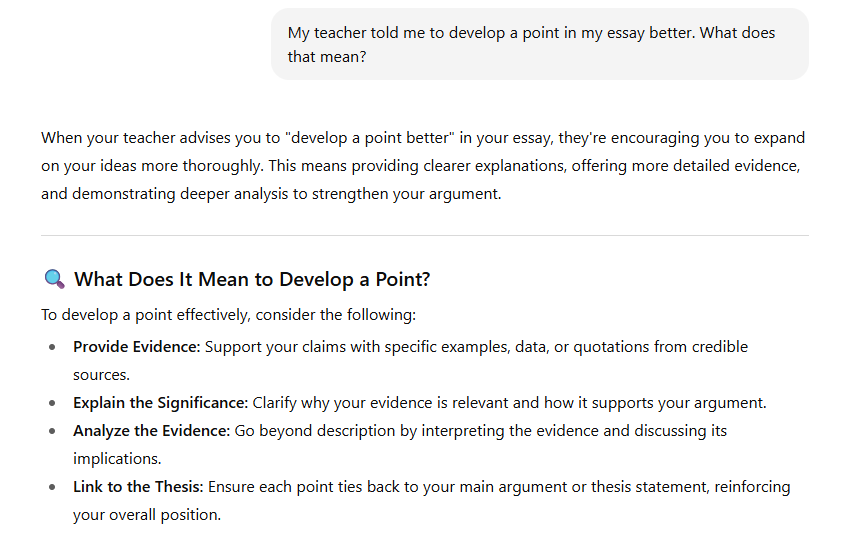
Photo by Kampus Production on Pexels
AI literacy is predicted to become one of the key skills required in order to be successful and up-to-date in the working world. Not teaching students how to effectively use it would put them at a disadvantage down the road. However, reliance on AI is also a big concern surrounding young people; many worry that it will reduce their critical thinking abilities and interrupt their learning potential.
So, here are four ways that students can utilise AI as a tool, and not misuse it to do their work for them.
1. Using AI as teacher support
A lot of classes contain too many students for a single teacher to be able to provide adequate support to each and every one of them, let alone focus on each student’s individual struggles. There unfortunately just isn’t enough time and aren’t enough resources during lessons and the school year for teachers to teach their subject and make sure that every student has understood every challenging topic. There’s often the conflict between the stronger students who quickly grasp new information, and the weaker ones who require a bit of extra attention and time. It’s unrealistic to stop the class for every student who doesn’t understand something, but equally unrealistic to push on without addressing the class’s difficulties. It’s a very fine balance that can be helped with the use of AI.
In most classrooms nowadays, students have constant access to a computer or tablet. This means that in lesson time, they can have an AI model open, if needed, to act as a form of teacher support. They can ask the AI to simplify an explanation or provide clarification without stopping the class. At the opposite end, students who fully understand something that the teacher is going over, could ask the AI to test their knowledge on it. This allows teacher and student to go on as normal without worrying that too much or too little attention is being given. As a bonus, AI models store previous input and output, so students would be able to look back at their interactions with the AI to review and revise the new information.
2. Using AI as a portable teacher
In most cases, students only have access to their teacher’s guidance within the classroom. Often, students struggle most when it comes to doing work without a teacher present. When they get home and it’s time to do homework, or look back at marked work, for example, it can be tricky not to have a teacher at hand. For instance, say a student is struggling with grammatic point A whilst doing a gap fill exercise for homework. Instead of asking the AI to just fill the gap for them, they could ask it to explain grammatic point A in a way that will give them the skills to finish the exercise. AI can also be helpful when looking over a piece of marked work. A student could ask the AI to clarify why an answer is wrong – and then maybe even have it give them extra exercises to practise.


3. Using AI for writing practice
AI has developed to such an extent that it is capable of having a ‘conversation’ with those who write a prompt. It could be a good opportunity for students to practise their writing skills. They could even ask the AI to correct their spelling, punctuation and grammar as they go.
AI can provide help with essay writing, too. Students could ask for general tips, or a check list, or even specific questions related to teacher feedback, e.g., ‘How do I develop my point further in an essay?’.
However, students should not put in an entire essay and ask the AI to polish it up a bit. This then means that the student isn’t aware of where they’re not quite achieving. It defeats the point of critical thinking as students should learn to be able to check over their own work and correct their mistakes.

4. Using AI as a revision buddy
Students can often be challenged when revising, feeling unsure where to start or how they should be reviewing their work and making sure they know what they need to. A great way of using AI to help with revision is to upload study notes to the AI model and then ask it to generate quiz questions based off the content. Provided the students’ notes cover what they need to know, the AI will be able to highlight what they don’t know quickly and easily, showing the students exactly where they need to improve. Alternatively, students could just ask the AI to provide questions based on a topic, which would have the similar effect of testing the limits of the students’ knowledge. This ensures that the students are well-prepared for an exam, or even a real-life situation where they may need to apply their knowledge or skills.

The bottom line…
All in all, students shouldn’t be taught to avoid AI like the plague, but they also shouldn’t be taught to go to it for all of their problems. What they should learn, is about how AI is a support tool that can help them learn things more easily and how to apply it to their daily needs, which will then set them up for a future in which AI is an integrated part of life – whether we like it or not!
Further reading and resources
If you’re a teacher who’s interested in knowing more about implementing AI into your own teaching style, definitely check out this blog on using AI to help you plan your lessons and this blog that will help you asses your learners’ needs in the most effective way possible.
Finally, for further resources, be sure to register here for our up-and-coming instalment to the Teaching Skills Kit series, Lesson Planning for ELT: Frameworks & Principles for the Classroom, which features a chapter on AI-use and how it can be a really great teachers’ tool, as well as other great tips and tricks for planning a lesson.


